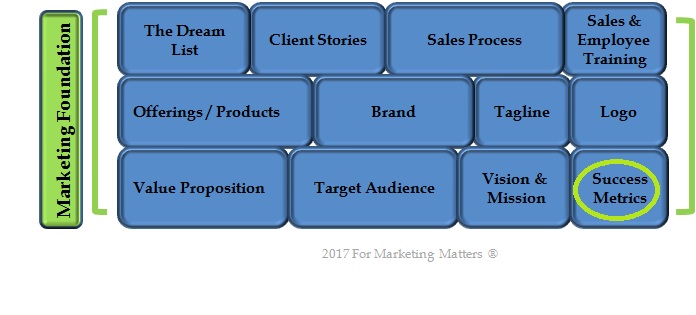We are fact based marketers. For each part of the marketing plan there is a metric defined to report and evaluate results. Accountability for results and detailed reporting is one of our differentiators from other marketing companies.
I am often asked how we track marketing results to report ROI. Monthly marketing results are presented via the For Marketing Matters Impact Report. This report is a marketing ROI report, customized for each client. The Impact Report shows the CEO (as well as CFO and others) their ROI with various metrics included. When I talk to prospects or colleagues about our commitment to accountability via the Impact Reports, I am commonly asked: What metrics do you report?
That question surprises me every time. The short answer is it depends on the client’s marketing priorities. However, I realize the bigger question people are really asking me is how can marketing impact be reported? Most CEOs of small and mid-sized businesses are not seeing marketing ROI. Many don’t know if their marketing investment is paying off or are unsure how to evaluate success. Wow! That blows my mind. Hence the reason for this blog. I want to help you, Mr./Mrs. CEO, realize there are many ways marketing can be and should be measured to help you evaluate marketing ROI.
Client-defined Marketing Success Metrics
To avoid recreating the wheel and to effectively go to market, we engage with every client in the same way. We start by assessing their foundation’s strength (see image below). As highlighted below, success metrics are critical to a strong foundation. If you don’t know where you are going, how do you know when you have arrived. We work with our client to get success metrics defined and documented. Specifically we hone in on how they will evaluate us as their full-service, outsourced marketing department. I seek accountability because I do not want any question of the impact we are delivering for our clients.
Marketing success is defined in two timeframes: the next six months and “long-term”. Why six months? This relatively short-term timeframe gives us two quarters to phase efforts, deliver impact and build positive momentum. Long-term provides important context to align the marketing efforts to goals ranging from 3 to 5 years. Knowing what long-term success looks like enables us to evaluate marketing strategies and prioritize efforts to make those goals a reality.
The For Marketing Matters Foundation and the Emphasis Placed on Determining Success Metrics::
How can marketing ROI be measured?
As a business owner, do you wonder if your marketing investments are paying off? Do you struggle with how to evaluate marketing success?
Marketing efforts can be measured. It is true some efforts can be more difficult to measure (e.g., branding). The foundation has to be solid in order to go market. Then as a small or mid-sized business, the core elements of the marketing plan should be focused in areas where results can be tracked. That does not limit your options! As detailed below, there are plenty of marketing efforts that can be measured to show marketing ROI.
To help you measure marketing ROI, below are metrics to consider tracking monthly. Rather than a long laundry list, the metrics have been aligned by three common marketing goals. I hope these examples assist you in measuring marketing results via metrics rather than gut feel.
Marketing Success Metrics to Evaluate ROI:
For this blog, suggested metrics have been organized around three possible marketing goals: working the top of the funnel to increase awareness, generating leads and managing online reputation.
Top of Funnel and Awareness:
If building awareness is a primary goal of your marketing plan, there are many metrics to evaluate success. Frequently, an awareness strategy can be achieved by educating and informing your target audience of what you do and how you do it. If that is part of your strategy and you are in the B to B space, I recommend you have a metric focused on content development. A very effective way to build awareness is through sharing customer case studies to help your target audience understand what you do and how you do it. Telling stories can be very effective. Consider establishing a goal for how many case studies are developed to support driving awareness.
In trying to avoid too much marketing speak, when you think of awareness, ask yourself, are we reaching our target audience effectively? Consider both frequency and recency metrics to gauge effectiveness. See below for metrics to evaluate how marketing is doing in the area of working the top of the funnerl:
Dream List – You need a dream list. Of the 13 foundational elements depicted above, this is the one that raises the most questions. What is a Dream List? It’s a company asset organizing information about your clients, prospects, referral sources, influencers and partners. This asset is critical for executing the marketing plan. It’s the asset to manage any and all communications. It can be developed in an Excel spreadsheet or utilizing sales automation software. Wherever you store it, the key is to be organized, accurate and maintained. Monthly marketing metrics should track metrics such as # new contacts, by industry and segment as well as quality indicators (% contacts with email, % contacts in top targeted industry). At a minimum you need to have it segmented so you can target the right audience for awareness with the right message. If you don’t have this asset in place, how can you target and reach your audience? Are you hoping your message is getting to the right audience or do you know for sure? Monthly reporting should also include which target audiences were reached to increase awareness. Make this a priority for your business if you don’t have a Dream List.
Email Marketing – Leveraging your Dream List, track # emails sent to which audiences and report metrics including # opens, # clicks; # of calls (use unique phone numbers); # of chats; # of forms submitted (use unique web landing pages). Where possible include industry open rates to evaluate if your marketing efforts are outperforming industry statistics.
Social Media – Social media should use the Dream List to reach groups mirroring target audience profiles. Monthly reporting of social media success metrics may include: impressions, engagement and followers. Monitor and report the top posts to help you learn what content your target audience reacts to in order to improve content development. Analyze when (day and time of day) your target audience is using which social media channels to refine your posting strategy.
Digital Advertising – You should expect detailed analysis on any digital advertising program including such metrics as impressions, clicks, calls, and sales (be sure to have unique landing pages and source codes tracking through systems).
Blogs – Blogs can be an effective way to educate or inform your ideal target audience about your offerings or services; track by each blog post which topics are getting the most views and comments. Monitor other industry blogs to comment and reach your ideal audience through related blogs.
SEO – Is your website optimized for organic search? This is step one for awareness. Once optimized, monitor and report key search term rankings. Metrics to report on should include search terms in top 10 and movement up or down over prior month. Related to organic search, track the new and unique content being added to your website each month. Be sure to feed “The Google Machine” to promote organic search results.
Google Analytics – Monitor website activity using Google Analytics. A useful way to review website activity is with a trend report of visits, unique visits, page views, bounce rates, referral sources and time on site by referral sources. A 13 month trend report is useful to identify seasonality.
This list is not meant to be exhaustive, but is intended to help you identify metrics to evaluate the success of your marketing efforts related to working the top of the funnel to increase awareness of your company and its offering..

Leads:
Your company should not be running any lead generation programs where you can not evaluate results. A challenge may be getting useful reports that make sense. Beware of ‘experts’ that dazzle you with reports full of jargon and ‘noise’! There is no need for lead reports to be frustrating, confusing and downright intimidating. Don’t accept that reporting! Your marketing team should be able to cut through the noise to quickly assess if a campaign is working or not. Below are suggested metrics to evaluate lead generation results:
Lead Quantity – Quantity of leads by campaign is a baseline metric. Make sure you have source codes so you can evaluate individual campaigns. Sounds easier than it is, but your marketing department should be in the weeds to make this happen.
Lead Quality – This metric can be challenging. What is a quality lead for your business? Your marketing team should work with sales to clearly define a quality lead. (Are you laughing yet? I am envisioning sales saying every lead sucks and marketing asking why leads are not being followed up on!) Part of marketing’s job is to write content and design web form submissions to appeal to the ideal target. Examples of ways to increase the quality of a B to B web lead could be to include required check boxes on the form asking if budget is approved, determining project timeline or having specs also submitted to indicate seriousness of the inquiry. Additional metrics to evaluate lead quality include: # leads marketing generates; # leads from existing clients and closure rates of marketing leads vs. other lead sources (e.g., sales generated).
Conversion – Marketing success metrics should track leads through the sales process including # leads converting to sales, profitability of the leads being converted vs. other lead sources. Follow the process through and where possible, compare to industry standards.
If lead generation is a priority, consider the above metrics to help you evaluate marketing’s impact and ROI.
Online presence:
One could argue that being found online is part of your efforts to increase the top of the funnel. I am separating this on purpose to highlight the importance of managing and monitoring how your business appears online. Marketing should be the keepers of your brand and that includes managing your online presence. You may assume marketing is focused on your website presence and that is all you need to manage (it’s not). Someone on your marketing should be monitoring and reporting on online presence metrics such as the following:
Online reputation – Proactively manage your online reputation.Just like the old adage, what gets measured gets managed. Don’t wonder what is being said about you on Yelp, Google or an industry forum. Monitor ratings, respond to posts and proactively manage what appears about your business when your company name is searched. Do a search and know where reviews of your business are appearing. You may be surprised.
Finally, manage your Google places page. We find that many businesses did not even know they had one to manage!

Just like reviewing your company’s financials each month, you should have a clear understanding of marketing’s ROI. Start with a focused, phased marketing plan and then review progress each month with a marketing ROI report. As CEO or President, if you aren’t seeing such a report, you need a new marketing partner. Marketing can be measured and it should be.

